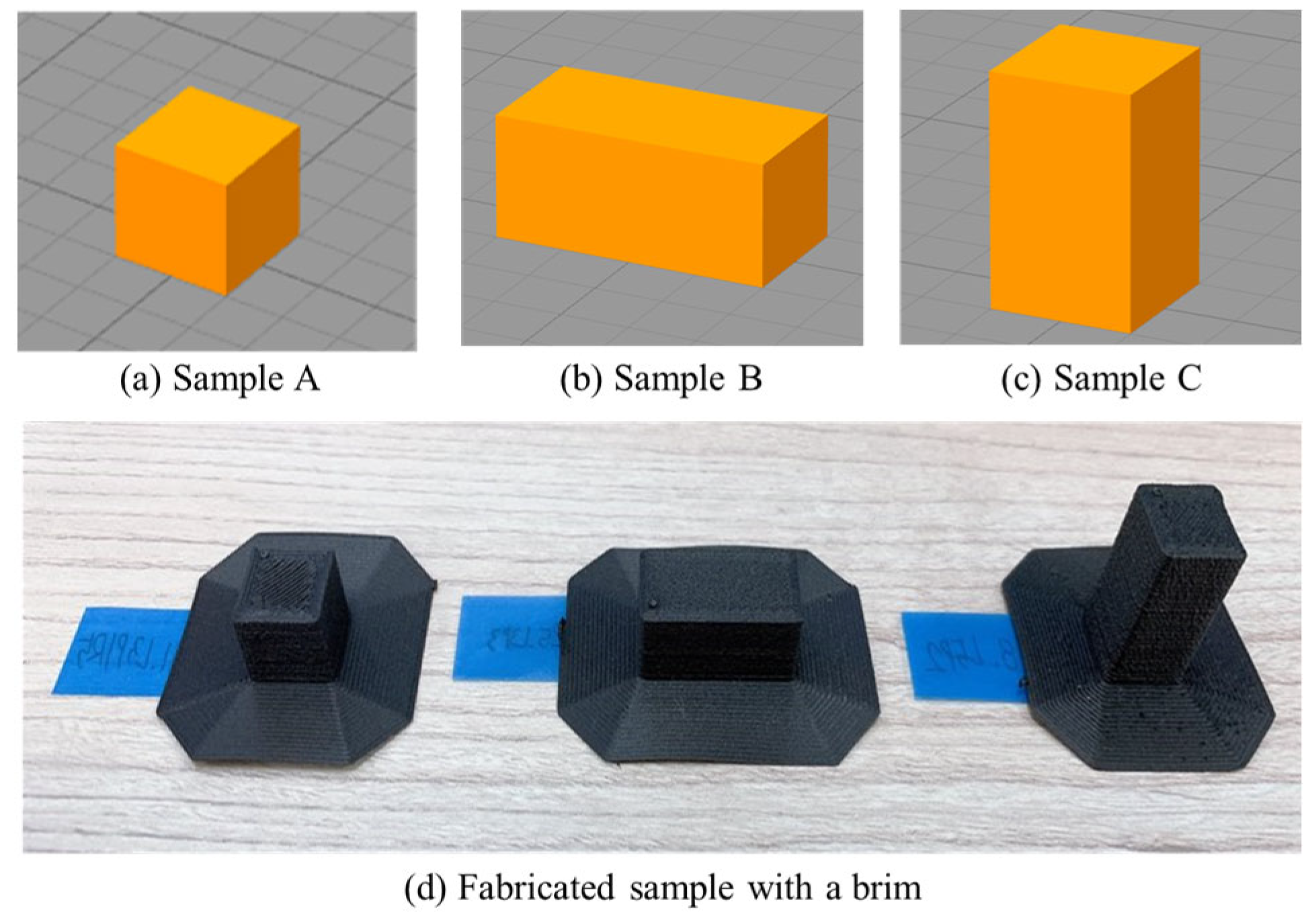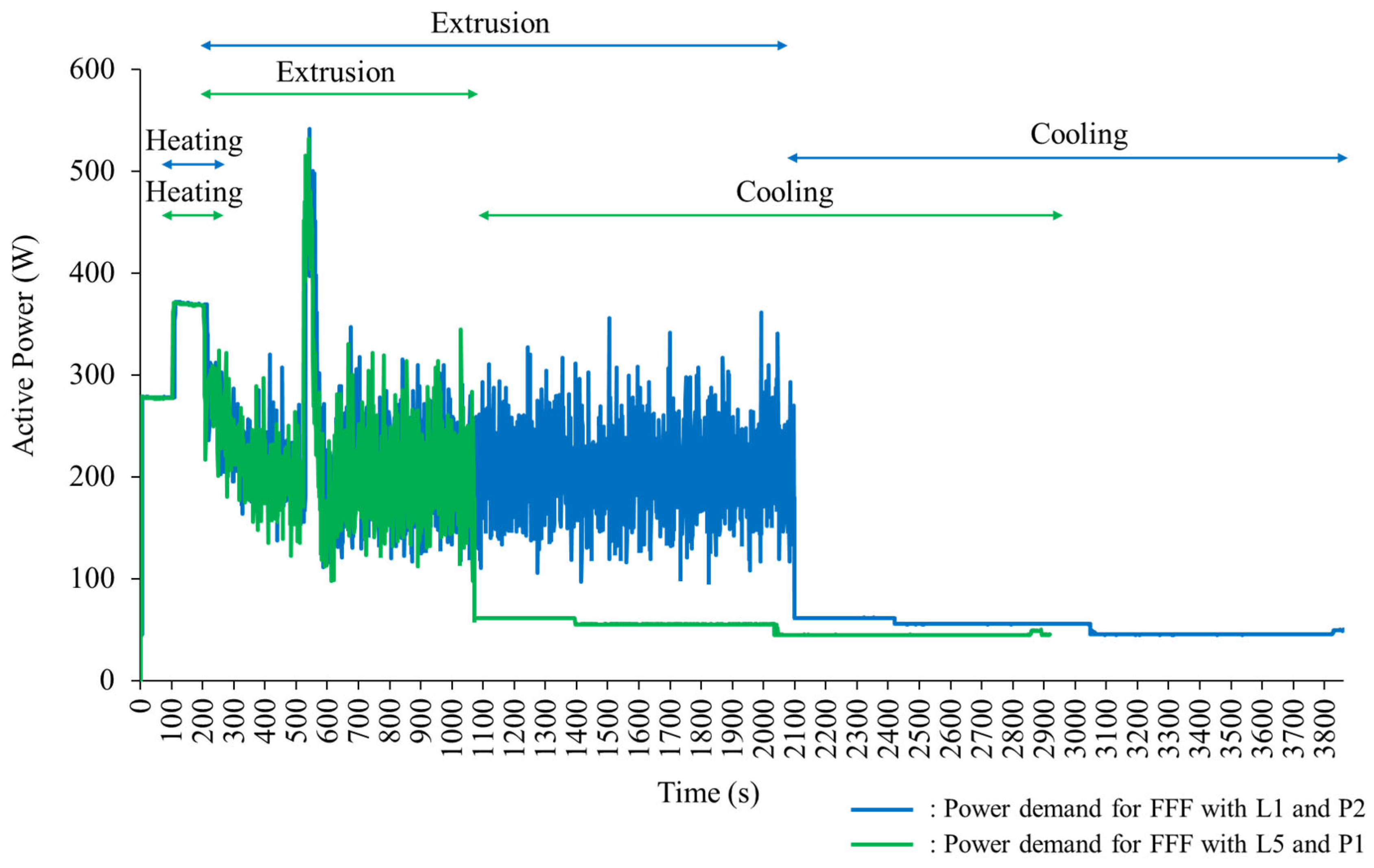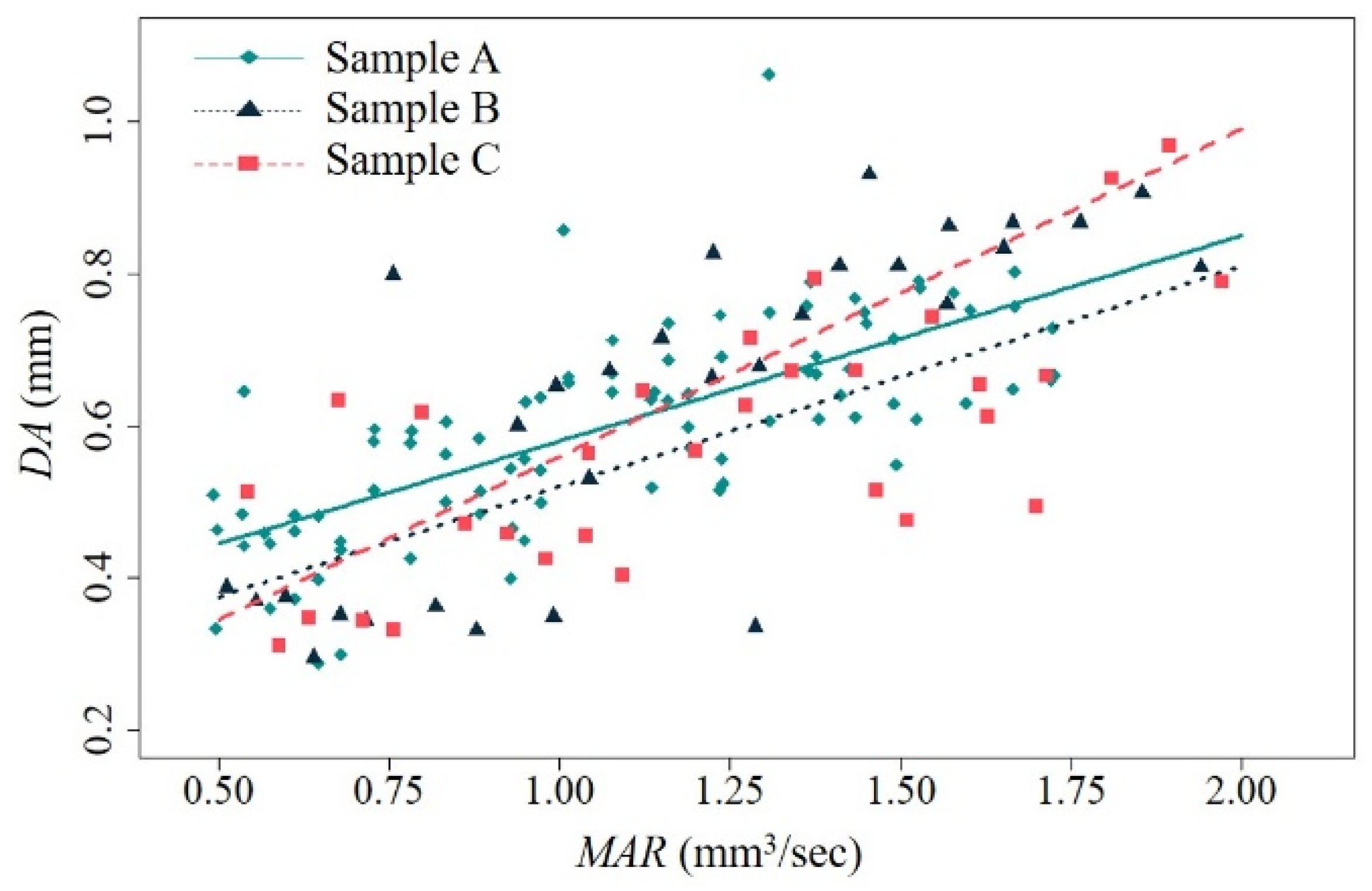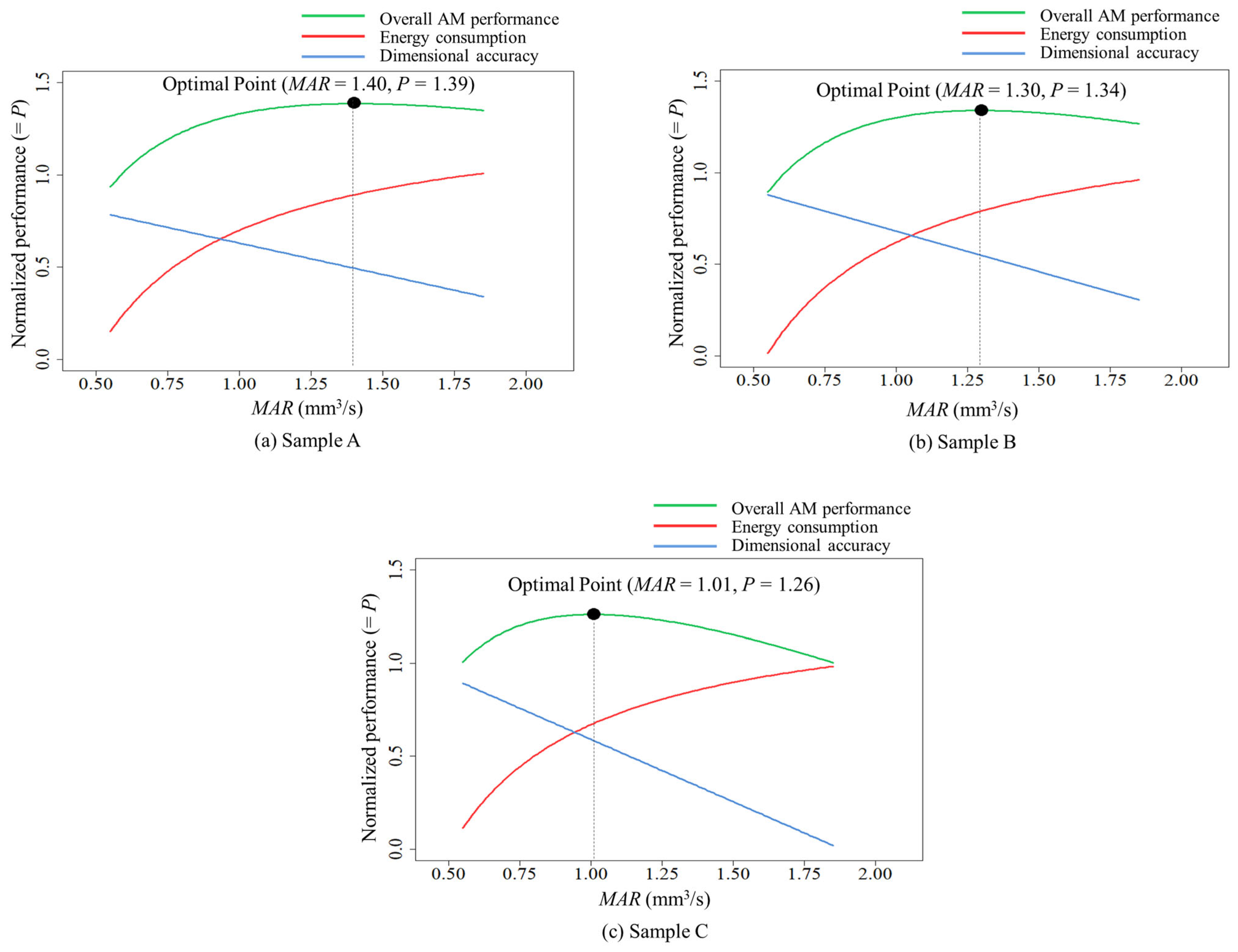Investigation of an Optimal Material Addition Rate for Energy Consumption and Dimensional Accuracy in Fused Filament Fabrication of CFR-PEEK
Abstract
1. Introduction
2. Materials and Methods
2.1. Design of the Experiment
2.2. Modeling Energy Consumption and Dimensional Accuracy on MAR
2.3. Optimal MAR Based on the Trade-Off between Energy Consumption and Dimensional Accuracy
3. Results
3.1. Energy Consumption and Dimensional Accuracy Models for FFF Using CFR-PEEK
3.2. Optimal MAR Considering Both Energy Consumption and Dimensional Accuracy
4. Discussion
5. Conclusions
Author Contributions
Funding
Institutional Review Board Statement
Data Availability Statement
Conflicts of Interest
References
- Peng, T.; Kellens, K.; Tang, R.; Chen, C.; Chen, G. Sustainability of additive manufacturing: An overview on its energy demand and environmental impact. Addit. Manuf. 2018, 21, 694–704. [Google Scholar] [CrossRef]
- Brenken, B.; Barocio, E.; Favaloro, A.; Kunc, V.; Pipes, R.B. Fused filament fabrication of fiber-reinforced polymers: A review. Addit. Manuf. 2018, 21, 1–16. [Google Scholar] [CrossRef]
- Ahn, S.H.; Montero, M.; Odell, D.; Roundy, S.; Wright, P.K. Anisotropic material properties of fused deposition modeling ABS. Rapid Prototyp. J. 2002, 8, 248–257. [Google Scholar] [CrossRef]
- Osswald, T.A.; Puentes, J.; Kattinger, J. Fused filament fabrication melting model. Addit. Manuf. 2018, 22, 51–59. [Google Scholar] [CrossRef]
- Oztan, C.; Ballikaya, S.; Ozgun, U.; Karkkainen, R.; Celik, E. Additive manufacturing of thermoelectric materials via fused filament fabrication. Appl. Mater. Today 2019, 15, 77–82. [Google Scholar] [CrossRef]
- Strano, M.; Rane, K.; Farid, M.A.; Mussi, V.; Zaragoza, V.; Monno, M. Extrusion-based additive manufacturing of forming and molding tools. Int. J. Adv. Manuf. Tech. 2021, 117, 2059–2071. [Google Scholar] [CrossRef] [PubMed]
- Rahmatabadi, D.; Ghasemi, I.; Baniassadi, M.; Abrinia, K.; Baghani, M. 4D printing of PLA-TPU blends: Effect of PLA concentration, loading mode, and programming temperature on the shape memory effect. JMatS 2023, 58, 7227–7243. [Google Scholar] [CrossRef]
- Chohan, J.S.; Singh, R.; Boparai, K.S.; Penna, R.; Fraternali, F. Dimensional accuracy analysis of coupled fused deposition modeling and vapour smoothing operations for biomedical applications. Compos. B. Eng. 2017, 117, 138–149. [Google Scholar] [CrossRef]
- Kumar, L.J.; Krishnadas Nair, C. Current trends of additive manufacturing in the aerospace industry. In Advances in 3D Printing & Additive Manufacturing Technologies, 1st ed.; Wimpenny, D.I., Pandey, P.M., Kumar, L.J., Eds.; Springer: Singapore, 2017; pp. 39–54. [Google Scholar]
- Liu, Z.; Wang, Y.; Wu, B.; Cui, C.; Guo, Y.; Yan, C. A critical review of fused deposition modeling 3D printing technology in manufacturing polylactic acid parts. Int. J. Adv. Manuf. Tech. 2019, 102, 2877–2889. [Google Scholar] [CrossRef]
- Balogun, V.A.; Oladapo, B.I. Electrical energy demand modeling of 3D printing technology for sustainable manufacture. Int. J. Eng. 2016, 29, 954–961. [Google Scholar] [CrossRef]
- Liu, Z.; Jiang, Q.; Ning, F.; Kim, H.; Cong, W.; Xu, C.; Zhang, H.-C. Investigation of energy requirements and environmental performance for additive manufacturing processes. Sustainability 2018, 10, 3606–3620. [Google Scholar] [CrossRef]
- Lunetto, V.; Priarone, P.C.; Galati, M.; Minetola, P. On the correlation between process parameters and specific energy consumption in fused deposition modelling. J. Manuf. Process. 2020, 56, 1039–1049. [Google Scholar] [CrossRef]
- Hassan, M.R.; Noh, H.; Park, K.; Jeon, H.W. Simulating energy consumption based on material addition rates for material extrusion of CFR-PEEK: A trade-off between energy costs and cycle time. Int. J. Adv. Manuf. Tech. 2022, 120, 4597–4616. [Google Scholar] [CrossRef] [PubMed]
- Balogun, V.A.; Kirkwood, N.D.; Mativenga, P.T. Direct electrical energy demand in fused deposition modelling. Procedia CIRP 2014, 15, 38–43. [Google Scholar] [CrossRef]
- Kim, K.; Noh, H.; Park, K.; Jeon, H.W.; Lim, S. Characterization of power demand and energy consumption for fused filament fabrication using CFR-PEEK. Rapid Prototyp. J. 2022, 28, 1394–1406. [Google Scholar] [CrossRef]
- Mohamed, O.A.; Masood, S.H.; Bhowmik, J.L. Optimization of fused deposition modeling process parameters: A review of current research and future prospects. Adv. Manuf. 2015, 3, 42–53. [Google Scholar] [CrossRef]
- Sheoran, A.J.; Kumar, H. Fused deposition modeling process parameters optimization and effect on mechanical properties and part quality: Review and reflection on present research. Mater. Today Proc. 2020, 21, 1659–1672. [Google Scholar] [CrossRef]
- Wang, C.C.; Lin, T.W.; Hu, S.S. Optimizing the rapid prototyping process by integrating the taguchi method with the gray relational analysis. Rapid Prototyp. J. 2007, 13, 304–315. [Google Scholar] [CrossRef]
- Sood, A.K.; Ohdar, R.K.; Mahapatra, S.S. Improving dimensional accuracy of fused deposition modelling processed part using grey taguchi method. Mater. Des. 2009, 30, 4243–4252. [Google Scholar] [CrossRef]
- Sahu, R.K.; Mahapatra, S.S.; Sood, A.K. A study on dimensional accuracy of fused deposition modeling (FDM) processed parts using fuzzy logic. J. Manuf. Sci. Prod. 2013, 13, 183–197. [Google Scholar] [CrossRef]
- Beniak, J.; Križan, P.; Šooš, Ľ.; Matúš, M. Research on shape and dimensional accuracy of FDM produced parts. In Proceedings of the 9th Thai Society of Mechanical Engineers, International Conference on Mechanical Engineering, Phuket, Thailand, 11–14 December 2018. [Google Scholar]
- Günay, E.E.; Velineni, A.; Park, K.; Okudan Kremer, G.E. An investigation on process capability analysis for fused filament fabrication. Int. J. Precis. Eng. Manuf. 2019, 21, 759–774. [Google Scholar] [CrossRef]
- Park, K.; Kim, G.; No, H.; Jeon, H.W.; Kremer, G.E.O. Identification of optimal process parameter settings based on manufacturing performance for fused filament fabrication of CFR-PEEK. Appl. Sci. 2020, 10, 4630. [Google Scholar] [CrossRef]
- Gutowski, T.; Jiang, S.; Cooper, D.; Corman, G.; Hausmann, M.; Manson, J.-A.; Schudeleit, T.; Wegener, K.; Sabelle, M.; Ramos-Grez, J.; et al. Note on the rate and energy efficiency limits for additive manufacturing. J. Ind. Ecol. 2017, 21, S69–S79. [Google Scholar] [CrossRef]
- Alizadeh, M.; Esfahani, M.N.; Tian, W.; Ma, J. Data-driven energy efficiency and part geometric accuracy modeling and optimization of green fused filament fabrication processes. J. Mech. Des. 2020, 142, 041701. [Google Scholar] [CrossRef]
- Ensinger. TECAPEEK CF30 Black. Available online: https://www.ensingerplastics.com/en/shapes/products/peek-tecapeek-cf30-black (accessed on 23 June 2022).
- Han, X.; Yang, D.; Yang, C.; Spintzyk, S.; Scheideler, L.; Li, P.; Li, D.; Geis-Gerstorfer, J.; Rupp, F. Carbon fiber reinforced PEEK composites based on 3D-printing technology for orthopedic and dental applications. J. Clin. Med. 2019, 8, 240. [Google Scholar] [CrossRef] [PubMed]
- Apium. Apium P220 Datasheet. Available online: https://apiumtec.com/download/apium-p220-datasheet (accessed on 13 July 2022).
- Simplify3D. Software Feature of Simplify3D. Available online: https://www.simplify3d.com/products/simplify3d-software/features/ (accessed on 14 July 2022).
- ADPower. HPM-100A. Available online: http://shop2.adpower21com.cafe24.com/product/wattman-hpm-100a/17/category/1/display/2/ (accessed on 14 July 2022).
- Mitutoyo. Absolute Digimatic Blade Type Caliper. Available online: https://www.mitutoyo.com/products/small-tool-instruments-and-data-management/calipers/digimatic-calipers/absolute-digimatic-blade-type-caliper/ (accessed on 14 July 2022).
- Minitab. Minitab 20.3.0 Update. Available online: https://www.minitab.com/en-us/support/minitab/minitab-20.3.0-update/ (accessed on 19 July 2022).
- Masud, A.S.; Ravindran, A.R. Multiple criteria decision making. In Operations Resesarch and Management Science Handbook, 1st ed.; Chapter 5; Ravindran, A.R., Ed.; CRC Press: Boca Raton, FL, USA, 2008; pp. 1–35. [Google Scholar]
- Caminero, M.A.; Chacon, J.M.; Garcia-Plaza, E.; Nunez, P.J.; Reverte, J.M.; Becar, J.P. Additive manufacturing of PLA-based composites using fused filament fabrication: Effect of graphene nanoplatelet reinforcement on mechanical properties, dimensional accuracy and texture. Polymers 2019, 11, 799. [Google Scholar] [CrossRef] [PubMed]






| Type | Process Parameter | Value |
|---|---|---|
| Varied | Layer thickness (mm) | 0.1 (L1), 0.15 (L2), 0.2 (L3), 0.25 (L4), and 0.3 (L5) |
| Printing speed (mm/min) | 1000 (P1), 1100 (P2), 1200 (P3), 1300 (P4), 1400 (P5), and 1500 (P6) | |
| Fixed | Bed temperature (°C) | 120 |
| Nozzle temperature (°C) | 510 | |
| Nozzle diameter (mm) | 0.4 | |
| Perimeter shells (# of layers) | 3 | |
| top layers/bottom layers (# of layers) | None | |
| Extrusion percentage for the first layer (%) | 96 | |
| Infill pattern (pattern) | Rectilinear | |
| Infill density (%) | 100 |
| Name | Definition | Unit |
|---|---|---|
| Build time (t) | The total time taken during the material extrusion stage | s |
| Deposited material volume (v) | The total volume of deposited material during the material extrusion stage | mm3 |
| Energy consumption (EC) | The total energy consumed during the extrusion stage | W·h |
| Dimensional accuracy (DA) | The root mean square error of a final output between original and measured dimensions | mm |
| Sample Type | Regression Model | R-Squared | (p-Value) | (p-Value) |
|---|---|---|---|---|
| Sample A | 99.74% | t = 33.51 (p = 0.00 **) | t = 183.03 (p = 0.00 **) | |
| Sample B | 99.82% | t = 15.60 (p = 0.00 **) | t = 126.21 (p = 0.00 **) | |
| Sample C | 99.68% | t = 12.26 (p = 0.00 **) | t = 93.24 (p = 0.00 **) |
| Sample Type | Regression Model | R-Squared | (p-Value) | (p-Value) |
|---|---|---|---|---|
| Sample A | 49.94% | t = 9.55 (p = 0.00 **) | t = 9.37 (p = 0.00 **) | |
| Sample B | 51.00% | t = 3.36 (p = 0.002 **) | t = 5.40 (p = 0.00 **) | |
| Sample C | 65.02% | t = 1.73 (p = 0.094) | t = 7.21 (p = 0.00 **) |
| Sample Type | Normalized EC Model | Normalized DA Model | AM Performance Model | Optimal MAR |
|---|---|---|---|---|
| Sample A | - Test for (p-value): 0.00 - Test for (p-value): 0.00 - R-squared: 99.74% | - Test for (p-value): 0.00 - Test for (p-value): 0.00 - R-squared: 49.94% | P = 2.34–0.67/MAR–0.34·MAR | 1.40 |
| Sample B | - Test for (p-value): 0.00 - Test for (p-value): 0.00 - R-squared: 99.82% | - Test for (p-value): 0.00 - Test for (p-value): 0.00 - R-squared: 51.00% | P = 2.48–0.74/MAR–0.44·MAR | 1.30 |
| Sample C | - Test for (p-value): 0.00 - Test for (p-value): 0.00 - R-squared: 99.68% | - Test for (p-value): 0.00 - Test for (p-value): 0.00 - R-squared: 65.02% | P = 2.61–0.68/MAR–0.67·MAR | 1.01 |
| Suggested Process Parameters | MAR | Measured EC | Measured DA |
|---|---|---|---|
| Sample A | 1.40 (optimal) | 51.4 (estimated) | 0.69 (estimated) |
| L4 and P4 | 1.38 | 52.2 | 0.66 |
| L4 and P5 | 1.42 | 50.9 | 0.64 |
| L5 and P1 | 1.37 | 53.5 | 0.74 |
| Sample B | 1.30 (optimal) | 96.8 (estimated) | 0.61 (estimated) |
| L3 and P4 | 1.27 | 98.2 | 0.63 |
| L3 and P5 | 1.34 | 93.8 | 0.67 |
| L4 and P1 | 1.28 | 99.2 | 0.72 |
| Sample C | 1.01 (optimal) | 123.6 (estimated) | 0.56 (estimated) |
| L2 and P5 | 0.99 | 126.3 | 0.35 |
| L2 and P6 | 1.04 | 122.1 | 0.53 |
| L3 and P1 | 0.99 | 129.3 | 0.65 |
Disclaimer/Publisher’s Note: The statements, opinions and data contained in all publications are solely those of the individual author(s) and contributor(s) and not of MDPI and/or the editor(s). MDPI and/or the editor(s) disclaim responsibility for any injury to people or property resulting from any ideas, methods, instructions or products referred to in the content. |
© 2024 by the authors. Licensee MDPI, Basel, Switzerland. This article is an open access article distributed under the terms and conditions of the Creative Commons Attribution (CC BY) license (https://creativecommons.org/licenses/by/4.0/).
Share and Cite
Kim, K.; Park, K.; Jeon, H.W. Investigation of an Optimal Material Addition Rate for Energy Consumption and Dimensional Accuracy in Fused Filament Fabrication of CFR-PEEK. Polymers 2024, 16, 492. https://doi.org/10.3390/polym16040492
Kim K, Park K, Jeon HW. Investigation of an Optimal Material Addition Rate for Energy Consumption and Dimensional Accuracy in Fused Filament Fabrication of CFR-PEEK. Polymers. 2024; 16(4):492. https://doi.org/10.3390/polym16040492
Chicago/Turabian StyleKim, Kyudong, Kijung Park, and Hyun Woo Jeon. 2024. "Investigation of an Optimal Material Addition Rate for Energy Consumption and Dimensional Accuracy in Fused Filament Fabrication of CFR-PEEK" Polymers 16, no. 4: 492. https://doi.org/10.3390/polym16040492
APA StyleKim, K., Park, K., & Jeon, H. W. (2024). Investigation of an Optimal Material Addition Rate for Energy Consumption and Dimensional Accuracy in Fused Filament Fabrication of CFR-PEEK. Polymers, 16(4), 492. https://doi.org/10.3390/polym16040492







